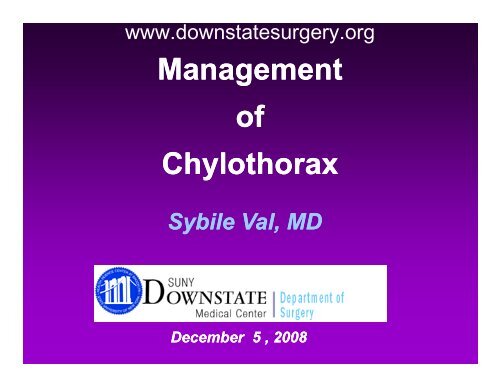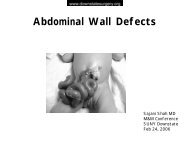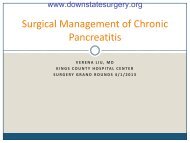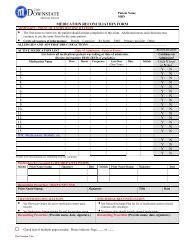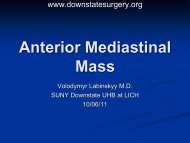Thoracic duct ligation
Thoracic duct ligation
Thoracic duct ligation
- No tags were found...
You also want an ePaper? Increase the reach of your titles
YUMPU automatically turns print PDFs into web optimized ePapers that Google loves.
www.downstatesurgery.orgManagementofChylothoraxSybile Val, MDDecember 5 , 2008
www.downstatesurgery.orgCase PresentationHistory• HPI:– 13 YOM withWaldmann’sdisease admitteddfor increasing LEswelling for past 2months• PMH:– Asthma– Primary Intestinallymphangiectasia– Protein losingenteropathy• PSH:–LIHR– Mediport (albumin)– Chest tube/PTdrainage x 3• Meds:– Aldactone– Aquadek– Lasix– Xopenex– Calcium
www.downstatesurgery.orgCase PresentationPhysical Exam & Labs• Physical Exam:– AAO x 3 in NAD, 53kg– Decreased BS right > left– Abdominal ascities– Pitting edema from b/l LE, genitalia and lowerabdomen• Labs:– CBC: 4/10/29/382– Chem: 144/4.7/113/24/27/0.4/96– LFTs: 3.7/2.9/15/6/74/0.3
www.downstatesurgery.orgCase PresentationRadiologic i Imaging
• HD# 2:www.downstatesurgery.orgCase PresentationHospital Course– Right sided pigtail placed by VIR– Started on TPN– Pleural fluid Analysis• Glucose -- 96• Protein --
www.downstatesurgery.orgCase PresentationRadiologic i Imaging
www.downstatesurgery.orgCase PresentationRadiologic i Imaging
www.downstatesurgery.org
www.downstatesurgery.org
www.downstatesurgery.org
www.downstatesurgery.org
• HD#3-7www.downstatesurgery.orgCase PresentationHospital Course– Pleural drainage monitored– Treatment with albumin, lasix and electrolytesupplementation initiated• HD#7– Cardiothoracic surgery consultation obtained
www.downstatesurgery.orgSybile didyou hearme?SorryRicci…I i thinkCHEESE!!!
www.downstatesurgery.orgCase PresentationOperation: <strong>Thoracic</strong> <strong>duct</strong> <strong>ligation</strong>
www.downstatesurgery.orgCase PresentationOperation: <strong>Thoracic</strong> <strong>duct</strong> <strong>ligation</strong>
www.downstatesurgery.orgCase PresentationOperation: <strong>Thoracic</strong> <strong>duct</strong> <strong>ligation</strong>
www.downstatesurgery.orgCase PresentationPathologyLymphatic vessel wallshowing edema,chronic inflammation,marked congestionwith recent and oldhemorrhage and focalfibrosis
www.downstatesurgery.orgImmediately Post-Op
www.downstatesurgery.orgPost Operatively• POD #1:– Pain controlled,tolerated diet– Decreased drainage• POD#4/6:– Chest tubes removed• POD#7:– Discharged home
www.downstatesurgery.orgThen what?
www.downstatesurgery.orgPost Post-Op• POD#9– Found to have fever of 101 in clinic– Admitted, urine culture +ve for E. coli– Dx: Urosepsis, discharged 2 days later– CXR: Negative• POD#39– Routinely scheduled echo large effusion– Underwent pericardial window (POD#48)– Doing well…
www.downstatesurgery.orgYesterday…• Admitted for regularlyscheduled albumininfusion… lastalbumin level 2.2• Reports decrease inLE swelling• Increased exercisetolerance• Overall…happy
www.downstatesurgery.orgQuestions??
www.downstatesurgery.orgChylothorax
www.downstatesurgery.org<strong>Thoracic</strong> <strong>duct</strong>• Ascends fromcisterna chyli• Enters thorax viaaortic hiatus• Lies between aortaand azygous until T5• Crosses over to leftbehind aortic arch
www.downstatesurgery.org<strong>Thoracic</strong> <strong>duct</strong>• Arches oversubclavian artery inanteriolateral superiormediastinum• Empties into thevenous circulation atjunction of left jugularand subclavian veins
www.downstatesurgery.orgChylothoraxTraumaticNon-TraumaticBluntPenetratingDiagnostic/VIRproceduresPost-OperativeCongenitalNeoplasmsInfectiousVenous thrombosisAutoimmune DiseaseRadiation exposure
• Rare disorder• Dilated intestinallacteals• Protein losingenteropathythwww.downstatesurgery.org– Lymphopenia– Hypoalbuminemia– HypogammaglobinemiaWaldmann’sDisease
• Symptoms:– B/L LE edema– Anasarcawww.downstatesurgery.org– Pleural effusion– Pericarditis– Chylous ascities• Diagnose withendoscopy• Confirmatory test:– 24 hour elevatedalpha-antitrypsinWaldmann’sDisease
www.downstatesurgery.orgClinical Presentation• Symptoms induced by mechanical effects– Gradual decrease in exercise tolerance– Dyspnea– Fatigue– Metabolic/Immunologic deficienciesFever and chest pain rarelyoccurs!
www.downstatesurgery.orgClinical Presentation• Pleural Fluid Analysis– Initial diagnostic test– Sample evaluated for:• Cell count• pH• Triglycerides110• Cholesterol• Glucose• Lactic dehydrogenase• Total protein• Cytology/culture
www.downstatesurgery.orgWork UpUnknown etiologyKnown etiologyCT scanthorax/abdomenLymphangiography/LymphoscintigraphyLymphangiography/Lymphoscintigraphy
www.downstatesurgery.orgLymphangiography• Main imagingmodality• Allows precisedefinition and locationof chylous leak• Identifies anatomicaberrations• Allows for selective<strong>duct</strong> <strong>ligation</strong>Porziella et al, Lymphangiography in recurrent spontaneous chyothorax, Eur J CT. 2007;32:536
www.downstatesurgery.orgTreatment Options• Conservative– Chest tube drainage– Low fat, medium chain TGs– Complete bowel rest and TPNOther considerations?– Octreotide• Decreases GI secretions andlymphatic flow by increasingresistance to splanchnic blood flowNicholas et al, Somatostatin in the treatment of Chylothorax, Chest. 2001;119:964-966
www.downstatesurgery.orgTreatment Options• Pleurodesis– Bleomycin– Talc– Tetracyline– *Sapylin• Biological preparation of streptococcus• Activates NKT cells• Induces pro<strong>duct</strong>ion of TNF, IL-6, VEGF, TGF-betaXu et al, Case Report: A case of chylothorax treated curatively with Sapylin, astreptococcus preparation, J Zhejiang Univ Sci B 2007; 8(12):885-887
www.downstatesurgery.orgWell Sybile, when do weoperate!?
www.downstatesurgery.orgSurgical Indications• Failure of conservative management• Recurrence after conservative mgmt– Timing i of surgery debatablebl– Usually between 1 – 3 weeks• Earlier intervention ti with large volumes of drainage(>1Liter/day)– Drainage >200 – 500ml/day
www.downstatesurgery.orgSurgical OptionsMechanical PleurodesisPleurectomyRight SD <strong>Thoracic</strong> <strong>duct</strong> <strong>ligation</strong>Pleuro-peritoneal shunting
www.downstatesurgery.orgSurgical OptionsChristodoulou et al, Video –assisted right supradiaphragmatic thoracic <strong>duct</strong> <strong>ligation</strong> fornon-traumatic recurrent chylothorax. EJCTS 2006;29:810-814
www.downstatesurgery.orgRight VATS, TDL• Six patients with recurrent/persistentchylothorax• Mean operative time – 102 min• No complications• Mean time of CT drainage 7 days• 90 day ypost-op p morbidity – zero• No recurrence after 41 month f/u (5/6)Christodoulou et al, Video –assisted right supradiaphragmatic thoracic <strong>duct</strong> <strong>ligation</strong> fornon-traumatic recurrent chylothorax. EJCTS 2006;29:810-814
www.downstatesurgery.orgDoc, is there a less invasiveoption?
www.downstatesurgery.orgTreatment• Percutaneous catheterization– First described by Cope an colleagues in1999– Hoffer and colleagues described a modifiedtechnique in 2001• 11 patients– 5 underwent embolization– 45% success rate– No morbidity
www.downstatesurgery.orgHoffer et al, Treatment of Chylothorax: Percutaneous Catheterization of Embolization ofthe <strong>Thoracic</strong> Duct, AJR 2001;176:1040-2
www.downstatesurgery.orgHoffer et al, Treatment of Chylothorax: Percutaneous Catheterization of Embolization ofthe <strong>Thoracic</strong> Duct, AJR 2001;176:1040-2
www.downstatesurgery.orgHoffer et al, Treatment of Chylothorax: Percutaneous Catheterization of Embolization ofthe <strong>Thoracic</strong> Duct, AJR 2001;176:1040-2
www.downstatesurgery.orgHoffer et al, Treatment of Chylothorax: Percutaneous Catheterization of Embolization ofthe <strong>Thoracic</strong> Duct, AJR 2001;176:1040-2
www.downstatesurgery.orgSummary• Chylothorax rare but clinically devastatingentity with mortality rate as high as 50%• Diagnosis made with presence of >110 TG• Conservative management is initialtreatmentt t• Surgical intervention after 1-3 weeks ordrainage >500-1000/day• Perc intervention…wave of the future
www.downstatesurgery.orgQuestions…
www.downstatesurgery.orgThis Weeks’ ACS Questions1. A 62 YOF presents to the ER for evaluation of a pro<strong>duct</strong>ive cough. Shestates that her coughing began 6 weeks ago and she has been worsening;it is now associated with bloody sputum. She feels well otherwise anddenies having any recent fever or illness. Her medical history is significantfor a 40 pack-year history of smoking. The patient’s vital signs are normal.PE reveals course rhonchi throughout.Which of the following radiographic studies is most recommended for theevaluation of the patient’s hemoptysis?a. MRIb. Chest CT with contrastc. Routine CXRd. UltrasoundAnswer: B
www.downstatesurgery.orgThis Weeks’ ACS Questions2. A 65 YOF in the ICU is experiencing the acute onset of bleeding at hertracheal stoma site. Her tracheostomy tube has been in place for over 6weeks. The bleeding worsens throughout the day. Bronchoscopy reveals atracheoinnominate fistula.Which of the following treatments is most recommended for this patientscondition?a. Stabilization with rigid bronchoscopy followed by fistula resectionb. Placement of a tracheobronchial stentc. Bronchial biopsy to confirm diagnosisd. None of the aboveAnswer: A
www.downstatesurgery.orgThis Weeks’ ACS Questions3. A 35 year old airline pilot has acute shortness of breath and on physicalexamination he is found to have decreased breath sounds on the rightside. CXR reveals a pneumothorax and a chest tube is placed.The most appropriate management isa. Serial CXRb. Chemical pleurodesisc. Axillary thoracotomyd. VATSe. Posterior lateral l thoracotomytAnswer: D
www.downstatesurgery.orgThis Weeks’ ACS Questions4. A 43 year old woman presents with a 2 day history of fever, shortness of breathand cough pro<strong>duct</strong>ion of yellow sputum. On examination she has decreased dbreath sounds at base of left lung. CXR reveals opacification of the left diaphragmwith a large pleural effusion. CT scan shows a well circumscribed pleuralcollection without loculation. Diagnostic thoracentesis yields frank pus with gramnegative bacteria on gram stain.Appropriate management would include IV antibiotics anda. Needle drainageb. Ultrasound guided pigtailc. Bedside thoracostomyd. VATS decorticatione. Open decorticationAnswer: C
www.downstatesurgery.orgThis Weeks’ ACS Questions5. Which of the following about lung cancer is truea. Most common type of noncutaneous cancer in men and womenb. Most common cause of cancer death in men and womenc. Death reduced by 25% in smokers undergoing annual screening with CXRd. Metastatic disease to regional or distant sites already present in one fourth ofpatientse. Overall 5 year survival rate 25%Answer: B
www.downstatesurgery.orgThe End
www.downstatesurgery.orgReferences


